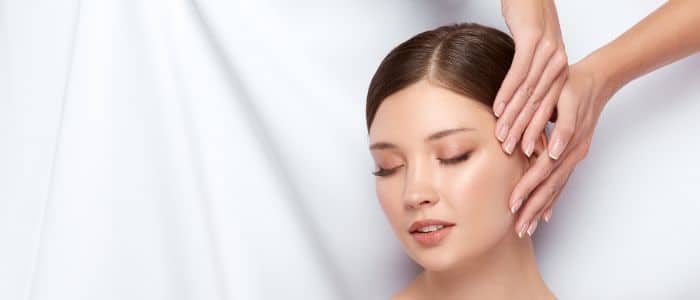
Table of Contents
- What Are the Alternatives to Facelift Surgery?
- What Is the Traditional Facelift?
- What Are Minimally Invasive Procedures?
- Popular Minimally Invasive Facelift Alternatives
- Dermal Fillers
- Laser Treatments
- Choosing the Right Procedure
- What to Expect After a Minimally Invasive Procedure
- Risks and Considerations
- FAQs about Minimally Invasive Facelift Alternatives
- Further Reading about Face Procedures with Consultant Plastic Surgeon Anca Breahna
What Are the Alternatives to Facelift Surgery?
In recent years, the quest for a youthful visage has seen a paradigm shift from traditional surgical facelifts to minimally invasive alternatives. The allure of these procedures lies in their promise of significant aesthetic enhancement without the extensive downtime and potential complications associated with conventional surgery.
In this blog, Chester Consultant Plastic Surgeon Anca Breahna discusses the spectrum of non-surgical facelift options that are revolutionising facial rejuvenation. She will explore the best procedures tailored for those seeking to refresh their appearance with minimal intrusion.
What Is the Traditional Facelift?
When we speak of turning back the clock on ageing, the traditional facelift has long been considered the gold standard. This surgical procedure, known in the medical community as rhytidectomy, has been refined over decades to address the visible signs of ageing in the face and neck areas.
The Anatomy of a Traditional Facelift
A traditional facelift involves a series of incisions beginning in the hairline at the temples, continuing around the ear, and ending in the lower scalp. Fat may be sculpted or redistributed from the face, jowls, and neck, and underlying tissue is repositioned. Often, the deeper layers of the face and the muscles are also lifted. Skin is then redraped over the uplifted contours, and any excess skin is trimmed away.
Post-surgery, patients can expect a recovery period that includes swelling, bruising, and a necessary hiatus from daily activities. Results are not immediate; as the swelling subsides and the face begins to heal, the full effects of the facelift become apparent. It’s a process that requires patience and, often, a strong tolerance for discomfort.
Opting for a traditional facelift is a significant decision. It requires a commitment not only in terms of the financial cost but also in the investment of time for both the procedure and the recovery. Moreover, as with any surgery, there are risks involved, including complications related to anaesthesia, infection, and scarring.
Despite its effectiveness, the traditional facelift is not without its drawbacks. The invasiveness of the procedure, the required general anaesthesia, and the potential for a lengthy recovery are considerable deterrents for many. Additionally, there’s the aspect of the ‘operated-on’ look, which can be a concern for those seeking more natural results.
As technology advances and our understanding of the ageing process deepens, the demand for less invasive procedures that offer a more natural appearance and shorter recovery time has grown. This has led to the development of a range of minimally invasive facelift alternatives. These alternatives are not only appealing to those who wish to avoid the rigours of surgery but also to a younger demographic seeking early intervention to delay the signs of ageing.
What Are Minimally Invasive Procedures?

These techniques offer a more subtle approach to anti-ageing, aligning with the modern ethos of ‘less is more’. Let’s discuss the factors that have contributed to the popularity of these procedures and why they are increasingly becoming the preferred choice for facial rejuvenation:
- Technological Advancements: Innovation in medical technology has been pivotal in the development of non-surgical facelift alternatives. Cutting-edge devices and improved materials have enabled practitioners to offer treatments that require minimal incisions, leading to reduced recovery times and lower risk profiles. These advancements have not only made the procedures more accessible but also more appealing to those who are apprehensive about traditional surgery
- Tailored Treatments: Minimally invasive procedures can be customised to address specific areas of concern. Unlike the all-encompassing approach of a traditional facelift, these treatments can target problem areas such as fine lines, wrinkles, volume loss, and skin laxity with precision. This bespoke approach ensures that patients receive only the necessary intervention to achieve their desired results
- Reduced Downtime: One of the most compelling advantages of minimally invasive procedures is the minimal downtime required. Many treatments can be performed in under an hour and do not necessitate a prolonged recovery period. Patients can often resume their normal activities immediately or within a few days, which is a significant benefit for those with busy lifestyles
- Cost-Effectiveness: While the cost of minimally invasive procedures can vary, they are generally more affordable than traditional facelift surgery. The reduced cost is due to several factors, including the lack of need for general anaesthesia, shorter procedure times, and the ability to perform the treatments in a clinic setting rather than a hospital
- The Natural Look: Minimally invasive facelift alternatives are designed to enhance and rejuvenate the face without the tell-tale signs of surgery. The goal is to create a refreshed and revitalised appearance that looks natural. This subtlety is often preferred by individuals who wish to avoid drastic changes and maintain a look that is true to their natural ageing process
- Safety Profile: With any medical procedure, safety is paramount. Minimally invasive techniques have a generally favourable safety profile, especially when performed by skilled and experienced practitioners. The reduced risk of complications such as infection, scarring, and anaesthesia-related issues is a significant factor in their popularity
- The Growing Demand: The demand for minimally invasive procedures has surged as awareness of these options has increased. Social media, along with the desire to maintain a youthful appearance in a society that values wellness and vitality, has contributed to their mainstream acceptance. People now have more information at their fingertips and are making informed decisions to opt for less invasive cosmetic enhancements
Popular Minimally Invasive Facelift Alternatives
The cosmetic enhancements have expanded to include a variety of non-surgical procedures that offer significant anti-ageing benefits without the need for extensive surgery. Here are some of the most sought-after minimally invasive facelift alternatives that are renowned for their efficacy and minimal downtime:
Dermal Fillers
Dermal fillers have become a cornerstone in the field of non-invasive facial rejuvenation. These gel-like substances are injected beneath the skin to restore lost volume, smooth lines, soften creases, or enhance facial contours. Here’s what you need to know about dermal fillers:
- Types and Materials: There are various types of fillers, such as hyaluronic acid, calcium hydroxylapatite, and poly-L-lactic acid, each with specific properties and longevity
- Procedure: The injection process is relatively quick, typically taking less than an hour, and results are immediate
- Recovery: There is minimal recovery time, with most patients returning to normal activities right after the procedure
- Results: While not permanent, fillers offer a temporary solution for ageing signs, with results lasting from 6 months to over a year, depending on the type used and the individual’s skin
Skin Relaxing Injections
Skin relaxing injections are another pillar in non-surgical facial treatments. They work by temporarily paralysing the muscles that contribute to wrinkles, such as frown lines and crow’s feet.
- Mechanism: These injections block the nerve signals to the muscles, which reduces the muscle activity that causes lines to form
- Procedure: The treatment is quick, often completed within 10 to 20 minutes, and does not require any downtime
- Recovery: Patients can usually resume their day immediately, with only minor redness or swelling
- Results: The effects last for about 3 to 4 months, after which the treatment can be repeated to maintain the desired look
Laser Treatments
Laser treatments utilise focused light therapy to stimulate collagen production, which helps to improve the skin’s tone and texture, resulting in a more youthful complexion.
- Types of Lasers: There are ablative lasers that remove thin layers of skin and non-ablative lasers that target the dermis to promote collagen growth without surface damage
- Procedure: Depending on the intensity of the laser, the procedure can take anywhere from 15 minutes to an hour
- Recovery: Recovery can vary, with some treatments requiring a few days of downtime, while others allow for immediate return to activities
- Results: Results can be seen after the skin heals, with improvements continuing to develop over the following months
Choosing the Right Procedure
Selecting the appropriate minimally invasive procedure is crucial and should be based on individual skin concerns, desired outcomes, and lifestyle. A consultation with a qualified cosmetic surgeon such as Anca can provide personalised advice and ensure that the chosen treatment aligns with the patient’s aesthetic goals.
What to Expect After a Minimally Invasive Procedure
Undergoing a minimally invasive procedure is only part of the journey towards achieving a rejuvenated appearance. Understanding the recovery process and aftercare is essential for ensuring the best possible outcomes. Here’s what patients can expect following a minimally invasive facial treatment:
Immediate Aftercare
- Post-Treatment Instructions: Patients will receive specific instructions from their practitioner, which may include applying ice to reduce swelling, avoiding certain activities, and recommendations on sleeping positions
- Managing Expectations: Some treatments may result in immediate improvements, while others may take days or weeks before the results fully materialise
- Side Effects: Common side effects such as swelling, redness, and bruising are usually temporary and subside within a few days
Long-Term Care and Maintenance
- Follow-Up Appointments: These are crucial for assessing the healing process and discussing any concerns with the practitioner
- Maintenance Treatments: Some procedures may require repeat sessions to maintain results, and scheduling these in advance can ensure continuity of appearance
- Skincare Regimen: A tailored skincare routine can enhance and prolong the effects of the treatment. This may include sun protection, moisturising, and the use of specific cosmeceutical products
Lifestyle Considerations
- Sun Exposure: Minimising sun exposure and using high-SPF sunscreen can help maintain the results of the procedure and protect the skin from further damage
- Healthy Habits: A balanced diet, adequate hydration, and not smoking can contribute to better skin health and longer-lasting results
Risks and Considerations
While minimally invasive procedures are generally considered safe, they are not without risks. It is important for patients to be aware of potential complications and to weigh these against the benefits of the treatment:
Potential Risks
- Allergic Reactions: Although rare, some individuals may have allergic reactions to certain materials used in fillers or other agents
- Infection: As with any procedure that involves breaking the skin, there is a risk of infection, which underscores the importance of choosing a reputable practitioner
- Dissatisfaction with Results: There is always a possibility that the results may not meet the patient’s expectations, which can sometimes be addressed with additional treatments
Choosing the Right Practitioner
- Qualifications and Experience: Ensure that the practitioner is qualified and experienced in performing the chosen procedure
- Portfolio of Work: Reviewing before-and-after photos of previous patients can provide insight into the practitioner’s skill level
- Consultation: A thorough consultation should include a discussion of the risks and benefits, as well as an assessment of the patient’s medical history
FAQs about Minimally Invasive Facelift Alternatives

How long do the results of minimally invasive facelift alternatives last?
The duration of results can vary widely depending on the type of procedure. For example, the effects of dermal fillers can last from 6 months to over a year, while skin relaxing injections usually last about 3 to 4 months. Laser treatments can have longer-lasting results that may improve over time with a proper skincare regimen. The longevity of results also depends on factors such as the patient’s skin type, lifestyle, and age.
Are minimally invasive facelift alternatives suitable for all skin types?
Most minimally invasive procedures are suitable for a wide range of skin types. However, certain treatments may have different efficacy levels on varying skin tones and conditions. It is important to have a detailed consultation with a cosmetic professional who can advise on the best treatment for your specific skin type and concerns.
Can minimally invasive procedures address sagging skin?
Yes, certain minimally invasive treatments are designed to tighten and lift sagging skin. Laser treatments, for instance, can stimulate collagen production, leading to firmer skin over time. However, the degree of sagging and the desired outcome should be discussed with a practitioner, as severe cases might require more intensive treatment options.
Is there any way to prolong the effects of minimally invasive facelift alternatives?
To prolong the effects of these treatments, patients should adhere to a comprehensive skincare routine that includes sun protection, hydration, and possibly the use of products that promote collagen production. Maintaining a healthy lifestyle, avoiding smoking, and scheduling maintenance treatments as recommended by your practitioner can also extend the benefits.
What is the best way to ensure a natural-looking result from minimally invasive facelift alternatives?
To achieve natural-looking results, it is crucial to select a qualified and experienced practitioner who understands facial anatomy and the subtleties of facial aesthetics. Discussing your goals and expectations clearly during the consultation will help the practitioner tailor the treatment to your features. Additionally, starting with a conservative approach and building upon the results gradually can often lead to the most natural and satisfying outcomes.
Medical References about Facelift Alternatives
- Nonsurgical Facelift: What It Is, Options & Benefits
- Update on Minimally Invasive Face Lift Technique
- Application of Nonsurgical Modalities in Improving Facial Aging
- Nonsurgical Facial Rejuvenation Procedures in Patients Under 50 Prior to Undergoing Facelift: Habits, Costs, and Results
- Nonsurgical modalities to treat the aging face
Further Reading about Face Procedures with Consultant Plastic Surgeon Anca Breahna
- Read more about What Are Hooded Eyelids?
- Read more about Features of a Beautiful Face
- Read more about Facial Rejuvenation Options for an Ageing Face
- Read more about Where to Get Skin Relaxing Injections in Chester
- Read more about Dermal Filler Clinic in Chester






